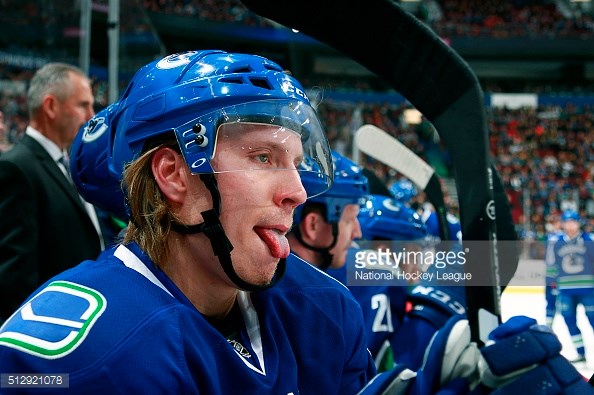Markus Granlund came to Â鶹´«Ã½Ó³»in a mildly controversial manner, with Hunter Shinkaruk heading the other direction.
There had been growing excitement among Canucks fans about Shinkaruk, who had shaken off a tough rookie season in the AHL to lead the Utica Comets in scoring in his second professional year, scoring 21 goals and 39 points in 45 games. With the Canucks struggling to score goals—they finished the season with the lowest goals-per-game in franchise history—it seemed inexplicable that they would trade away someone with Shinkaruk’s scoring touch.
But Jim Benning declared that he wasn’t sure if Shinkaruk could translate that scoring to the NHL and decided to move him before finding out if he could.
So Granlund arrived with one strike against him: he wasn’t Shinkaruk, a player that Canucks fans had seen drafted and developed in the Canucks system. Fans had little knowledge of Granlund, who had yet to make much of an impact for the Flames.
That was the second strike: while it’s uncertain whether Shinkaruk’s AHL scoring will translate to the NHL, Granlund has yet to see his own AHL scoring translate. Like Shinkaruk, Granlund put up points in the AHL—his 25 goals and 46 points in 52 games at age 20 looks pretty similar to Shinkaruk's past year with the Comets—but has just 16 goals and 31 points in 102 NHL games. He’s also two years older than Shinkaruk.
In his 16 games with the Canucks this past season, Granlund didn’t show much by the eye test. He showed decent vision at times, made a good pass here or there, but gave no indication that he could be an impact player either offensively or defensively.
Sometimes advanced statistics can help us appreciate a player's value when his game doesn't immediately jump off the ice, but they don’t help Granlund's case. On what was already a bad possession team in Calgary, Granlund was the worst forward on the team in fenwick—the percentage of unblocked shots directed at the opponent’s goal as opposed to your own. When he was on the ice for the Flames, they directed fewer shots on goal relative to his ice time than any other forward. He did next to nothing offensively and did not make up for it with his defensive play.
There are still some things working in Granlund’s favour. The first is his age, as he just turned 23 and has time to improve. As negative as I have been in this post, I sincerely hope he develops into a useful player for the Canucks.
The second is his new contract, which will frustrate anyone looking for further reasons to be upset about Benning and Granlund. He re-signed with the Canucks to a two-year deal with an average annual value of $900,000.
That’s a perfectly reasonable contract for someone who will likely start the season on the fourth line, with some room to move up the lineup as the season progresses. It also conveniently fits under the minimum amount for burying a contract in the AHL: if Granlund stumbles out of training camp or struggles during the season, he can be sent down to the AHL and not take anything out of the Canucks’ cap space.
Essentially, Granlund has two seasons to prove that he can be better than he has been so far in his NHL career. He has two seasons to show that acquiring him for Shinkaruk wasn’t a mistake. He has two seasons to win over Canucks fans who have yet to be impressed.
Ìý



